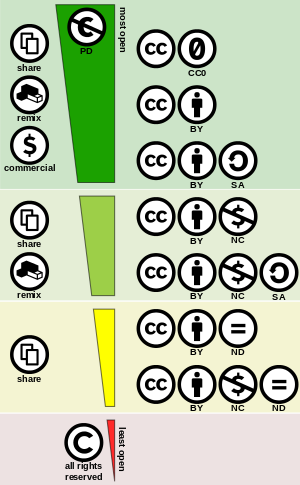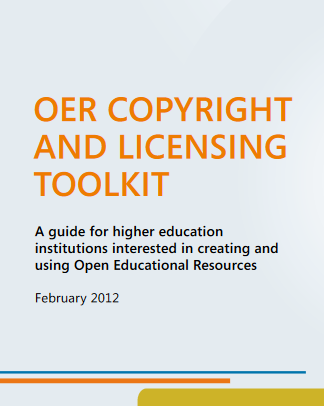We return to the William and Flora Hewlett Foundation (2016) OER definition provided in the introduction and unpack the implications of the statement with respect to realizing the related conditions and permissions.
‘Open Educational Resources are teaching, learning, and research resources that reside in the public domain or have been released under an intellectual property licence that permits their free use and repurposing by others. OER include full courses, course materials, modules, textbooks, streaming videos, tests, software, and any other tools, materials, or techniques used to support access to knowledge.’
Why Open Licensing?
The term ‘intellectual property licence’ may sound daunting, but the concept and practice of sharing OER using an open licence is an advantage as it provides resource creators with control over how their work is accessed, used, and disseminated by others. This is important to academics at higher education institutions who may place great value on retaining their own (or their institutions’) intellectual property rights, while sharing their work with others.
The most common form of legally sharing your own educational resources openly is to use the Creative Commons framework of licences. The organization ‘provides free, easy-to-use copyright licences to make a simple and standardized way to give the public permission to share and use your creative work – on conditions of your choice’. So, we need to understand these licences to apply them to our own work and to find out if and how we may use the work of others.
What are the Creative Commons licences and how do I recognize them?
CC licence permissions are made up of one or more component conditions:
 | Attribution (BY) You require that others who use your work in any way must attribute it – that is, must reference the work, giving you credit for it – the way you request, but not in a way that suggests you endorse them or their use of the work. If they want to use your work without giving you credit or for endorsement purposes, they must obtain your permission first. |
 | Non-Commercial (NC) You permit others to copy, distribute, display, perform, and (unless you have chosen No Derivatives) modify and use your work for any purpose other than commercially. If they want to use your work commercially, they must obtain your permission first. |
 | No Derivative Works (ND) You permit others to copy, distribute, display and perform only original copies of your work. If they want to modify your work, they must obtain your permission first. |
 | Share Alike (SA) You permit others to copy, distribute, display, perform, and modify your work, provided they distribute any modified work on the same licence terms. If they want to distribute modified works under other terms, they must obtain your permission first. |
Some of these conditions can be used in conjunction with each other and some are mutually exclusive. For example, if you are not allowed to modify an OER (ND), then there is no relevance to the sharing condition (SA).

Image Source: Creative Commons
The above diagram shows some valid licence combinations as depicted by Creative Commons, ranging from most open (free cultural work) to least open (most restrictive).
The CC licences on the OER you create or find should then incorporate and display the conditions, using the appropriate CC logo for easy recognition, as shown below.

Image source: Creative Commons
Let’s sum up using an open video resources:
Creative Commons Licences Explained 2011 (5.32 min)
An informative CC licensing document is available on the OER Africa database: OER Copyright and Licensing Toolkit. An updated online version is also available on the website.
This toolkit is aimed at higher education stakeholders who are working with OER. It explains copyright and describes the different licensing options available to the author/creator of a work. Whether you are wanting to license your own work or are tasked with clearing copyrighted documents, you will find comprehensive information about the basic concepts in copyright and licensing, the types of open licences that exist, and tools and techniques to provide support.
Permissions
What do all these open resources mean for us in terms of use? Essentially there is a group of permissions to guide us. David Wiley has clarified this for the OER community by developing what he has termed the ‘5Rs’ of Open Content and OER. This is a framework of permitted activities when working with OER under the CC licence conditions:
Retain – the right to make, own, and control copies of the content
Reuse – the right to use the content in a wide range of ways (e.g., in a class, in a study group, on a website, in a video)
Revise – the right to adapt, adjust, modify, or alter the content itself (e.g., translate the content into another language)
Remix – the right to combine the original or revised content with other open content to create something new (e.g., incorporate the content into a mashup)
Redistribute – the right to share copies of the original content, your revisions, or your remixes with others (e.g., give a copy of the content to a friend)
Below is a short video summary of these permissions:
‘5Rs’ of Open Content and OER (0.27 min)

- Do you need any clarification around open licensing? See Creative Commons licensing for more detailed explanations of the Creative Commons licences.
- Are you clear on what the permissions involve?

